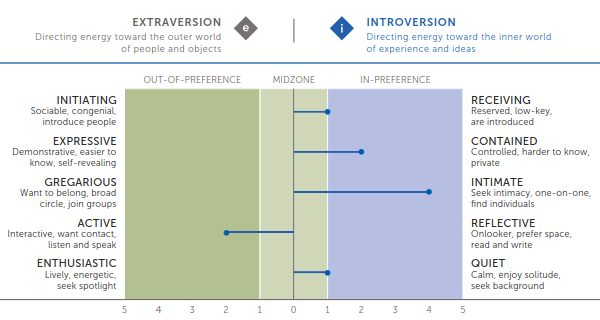
Having endured decades of research, development and numerous updates, we know that the Myer Briggs Type Indicator (MBTI) tool has certainly evolved from something far greater that just four letters, but how? With the new Step II Interpretive Report, the MBTI tool is capable of providing individuals with an in-depth and personalised description of their personality preferences that goes deep in to facets, preferences and areas to flex.
Before we start, it’s important to understand that there’s more than one form of report for the MBTI tool. The Step I Report calculates your preferred dichotomies (i.e. Extraversion/Introversion, Sensing/iNtuition, Thinking/Feeling, Judging/Perceiving) into a four-letter type and the Step II Report breaks them down into the unique ways that an individual will express them. We couldn’t possibly give someone four-letters and expect them to think, move and act as a person with the same results. We’re human of course, no two of us are the same! So how does the Step II Report break these four letters down into a tailored message and insights for each person?
Facets
For each of the four dichotomies in a Step II report, there are five separate components called Facets. By understanding your individual result for each facet, you are able to better understand your unique way of experiencing and expressing your type. The full list of facets for each dichotomy is shown below.

In/Out of Preference Facets linked to Dichotomies
The MBTI Step II report also measures how clearly these facets are scored to our dichotomies (four-letter type) in a graph (i.e. in-preference or out-of-preference). Believe it or not, it’s very common for reports to show scores with facets that are out-of-preference to an individual’s type letter. The graph below shows a participant with a preference for Introversion that also enjoys interacting, listening and speaking with others (an Extroversion facet). This helps explain why some people get confused around their MBTI preference. Using the example graph below, this person may feel like an extrovert because they like contact and being active, though it is simply just an out of preference facet. With the report also including brief commentary around the behaviours displayed for each facet score, this component is incredibly powerful in helping an individual understand their unique experience and expression of their type.

Tailored tips for your Preferences to Communicating, Making Decisions, Managing Change, Managing Conflict
We understand that giving someone information about themselves is easy, but learning how to actually apply it is what counts! That’s why we love the four pages at the back of the MBTI Step II report tailored with tips for each preference to enhance how they communicate, make decisions and manage change or conflict. By using this information an individual is able to increase effectiveness of their interactions through an explanation of how their type may play out in certain situations and what they can do to improve their interactions with different preference types.
Dominant and Auxiliary Functions
The core elements of an individual’s type typically involves how they take in information (Sensing and iNtuition) and how they make decisions (Thinking or Feeling). With each person having a favourite way of doing these two things, the MBTI Step II Report helps an individual understand their dominant function (favourite) and auxiliary function (least favourite). By identifying these functions, an individual gains self-awareness around their naturally dominating response and what they can do to leverage or control it in certain environments or with individuals who have difference dominant and auxiliary functions to themselves.

Polarity Index
The polarity index, which ranges from 0 to 100, shows the consistency of a respondent’s facet scores within a profile. Whilst most adults score between 50-65, an index below 45 suggests that a participant may have answered the questions randomly, potentially lacks self-awareness or has recently experience trauma/uncertainty in their life. This polarity index flags questions for a facilitator and ensures that all profiles are valid and relevant for an individual.
The Introduction to Type Booklet (AKA. The secret weapon no one tells you about!)
This resource is a critical addition to the MBTI Step II report (and essentially the equivalent of icing on a cake!). It is a 52-page booklet sold separately to the MBTI Step II Report that allows participants to explore the characteristics of their four-letter type. This also includes information around how others may view them, what happens when they’re at their best and any potential areas for growth. Better yet, a participant can read the same information about all 16 four-letter types and find out more about their team members preferences. This tool can also be used to introduce the theory behind Myer Briggs, find the best fit type and even includes a unique code for interactive resources online.
So we can hopefully now agree that there’s certainly a lot more to the MBTI tool than four letters. For an online assessment that takes participants no longer than 20 minutes, the MBTI Step II report certainly provides a powerful resource for improving the way that not only individuals, but teams communicate and work in their natural preferences. Having successfully leveraged the Myer Briggs Type Indicator for a number of years with clients across Australia and New Zealand, the BRS Team are experts in supporting teams and individuals with this tool. If you would like any information around how we can work with you to implement in your team please contact us at enquiries@brsresults.com.



